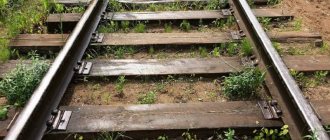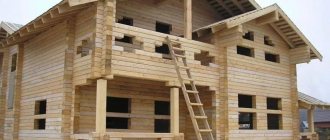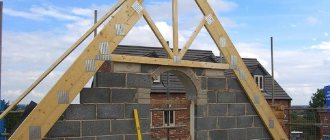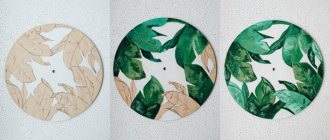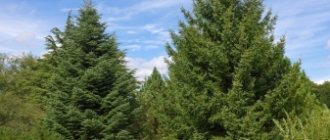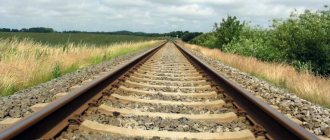The cross-sectional shape and dimensions of railway sleepers are standardized and must strictly comply with the technical regulations of GOST 78-2004 for each specific type of sleeper product. The purpose of railway tracks and their capacity is the main criterion for classifying sleepers and determining their overall parameters and other technical characteristics.
Terms and definitions:
- unimpregnated sleeper: Sleeper that has not been treated with protective agents.
- impregnated sleeper: Sleeper treated with protective agents.
- deep-pricked sleeper: A sleeper that has been specially treated by deep pricking in order to increase the depth of impregnation with protective agents.
- sleeper top: The sawn longitudinal surface of the sleeper, which has a smaller width.
- sleeper bottom: The sawn longitudinal surface of the sleeper, which has a large width.
- sleeper side: The sawn longitudinal side surface of the sleeper.
- wane part of the sleeper: Unsawed sections of the surface of the sleeper along the upper surface and side.
Length and width of wooden sleepers
The overall dimensions of the sleeper in length and cross-section are strictly predetermined in the state standard. In Russia, a uniform railway gauge of 1520 mm has been adopted for tracks of any purpose. Accordingly, the length of wooden or any other sleepers, regardless of the purpose of a particular section of the railway, is always the same and amounts to 2750 mm. Outdated narrow-gauge railway lines are isolated from the main railway network and are gradually being converted to the standard gauge gauge common to the entire country.
The width, height and cross-sectional shape of wooden sleepers according to the standard may vary depending on the load, purpose and speed limit on the railway section. The geometry of the profile affects the degree of resistance of the sleeper support to dynamic loads from the train passing on the railway.
- Type I – 180x250 mm, h 150 mm.
- Type II – 160x230 mm, h 130 mm.
- III type – 150x250 mm, h 105 mm.
The width of the wooden sleeper affects the contact area and the degree of frictional interaction with the ballast. This is an important parameter for uniform weight distribution without deformation of the rails. The height and shape of the profile affect the resistance of the sleeper beam to bending loads.
For impregnation of wooden sleepers the following is used:
- Creosote began to be used in the middle of the last century. The substance is toxic. Consists of phenol and phenolic ethers, which are harmful to humans and the environment.
- Elemsept is an antiseptic and includes concentrates of chromium, copper and arsenic oxides. Does not contain salts. Toxicity is significantly lower compared to creosote. Does not have an unpleasant odor.
- ZhTK is a thermal condensation liquid, a product of petroleum refining. The production technology is patented and is not publicly available. The product is non-toxic and does not have a specific odor.
The quality of impregnation of sleepers is regulated by GOST 20022.0 and GOST 20022.5.
Standard types of sleepers
The standard provides for the classification of wooden railway sleepers depending on the grade of the tracks and the method of processing the timber. All railways are divided into five classes, which determine their purpose, cargo flow and maximum permissible speed.
- 1st and 2nd classes - railway lines that can withstand train speeds of more than 100 km/h without significant deformation, with a total annual freight load of over 5 million ton-kilometers.
- 3rd and 4th – industrial and other access roads with high daily traffic intensity during sorting of trains at stations and at unloading and loading dead ends.
- 5th – lightly loaded railway tracks for shunting and other export purposes.
The sleeper grid must correspond to the class of the railways. There are four types of railway sleepers for this purpose.
- I – main trunk railway lines of 1st and 2nd classes.
- II – access and station sections of tracks of the 3rd and 4th classes.
- III – transport interchanges at industrial enterprises and at unloaded station dead-ends.
The processing method or cross-sectional shape of wooden sleepers is also classified according to the standard.
- Edged - profile shape in the form of a regular square.
- Semi-edged - one of the corners of the rectangular section is missing.
- Untrimmed – opposite edges have been removed. This is commonly found among used refurbished track sleeper components.
Each type and subtype of wooden rail sleepers has its own standardized overall dimensions and profile parameters to ensure a more uniform and safe load distribution on the railway track.
Impregnation depth standard:
| Name | Sapwood | For sound or mature wood |
| Pine and cedar sleepers | not less than 5 mm. | not less than 5 mm. |
| Spruce, fir and hardwood sleepers | not less than 5 mm. | not less than 2 mm. |
Sleepers must be deeply split before impregnation. Although, by agreement with the consumer, sleepers can be left unpinned. The best sleepers are made from pine, spruce, fir, larch and birch wood.
When making sleepers, wood moisture is not taken into account. Sleepers are sorted by type after impregnation.
Standard sizes of wooden sleepers
Natural solid pine, from which the wooden elements of the upper composition of the tracks are made, like any other wood, is subject to expansion and contraction when humidity changes. Standardized geometric parameters assume a normal moisture content of wooden sleepers of no more than 22%. In case of drying out or excessive wetting, the technical regulations of the standard provide for maximum allowances for changing the geometry of the profile and the length of the sleeper beam.
The amount of allowances when drying or soaking wooden sleepers is regulated by GOST 6282.1-75 for softwood timber and GOST 6282.2-75 for sleeper products made from deciduous wood.
As the class of railway tracks increases, the cross-section of wooden sleepers also increases for a more rational consumption of timber in the production of sleeper grids without losing the load-bearing capacity of the entire track according to the class of the railway. Allowances for the width of the lower surface of the sleeper beam remain unchanged - 5-20 mm. This makes it possible to unify the elements of the upper track structure and build a safe transition from one class to another along one track.
Marking corresponding to the type, breed and type of treatment of sleepers.
| Type of wood | Unpunctured | Deeply punctured | ||||
| | | || | ||| | | | || | ||| | |
| Pine | — | | | — | — | | | — |
| Spruce and fir | E | E| | E | E | E| | E |
| Larch | L | L| | L | L | L| | L |
| Birch | LE | LE| | LE | LE | LE| | LE |
Note:
The marking font is in accordance with GOST 14192. The prick mark is a spot in the form of a circle with a diameter of at least 10 mm.
Compliance of the sizes of railway sleepers with GOST
In Russia, as in other states of the Customs Union, a single interstate GOST 78-2004 has been in force since 2006. The technical regulations of this standard predetermine all the geometric parameters and technical and operational characteristics of the sleeper grid of the upper composition of railway tracks.
GOST 78-2004 strictly regulates all sizes of wooden sleepers and maximum permissible deviations from them. The sleeper beam must comply with the standard in terms of cross-sectional shape and linearity. There should be no longitudinal bends or twisting deformations. The cross-sectional geometry of a wooden railway sleeper must correspond to its type and class of railway. If there are deviations from the dimensions and geometry provided for by GOST, there is a high risk of deformation of the rail bed, which in itself is an emergency situation that can lead to disaster.
Changes in humidity, rotting and damage by all kinds of parasites can damage the integrity and strength of wooden sleepers. These factors also influence the cross-sectional dimensions and axial geometry of the sleeper beam. To prevent such changes and prevent destruction during the process of decay, the wood is impregnated with special antiseptic water-repellent compounds. By alternating between vacuum and high pressure, wooden sleepers are deeply impregnated with coal oil and fire retardants to prevent fire.
Technical requirements for the shape and dimensions of sleepers
Any deviations from the technical regulations of the state standard in cross-sectional shape and overall dimensions above the maximum permissible values are unacceptable and may lead to an emergency directly during the operation of the railway track.
- The opposite sides of the wooden sleeper beam must be strictly parallel to each other. The bottom support surface should be parallel to the top surface on which the rails are attached. The sides must be exclusively mutually parallel and perpendicular to the plane of the railway track.
- The ends of wooden impregnated and unimpregnated sleepers cannot be beveled at an angle. The surfaces of the end cuts must be strictly perpendicular to the longitudinal axis of the sleeper beam.
- The maximum deviations in the angles of inclination of the lateral vertical, supporting horizontal and end surfaces are regulated by the standard. Permissible bevels of cuts at the ends of wooden sleepers relative to the longitudinal axis cannot be more than 20 mm in width and thickness.
- The technical regulations of the standard also provide allowances for overall dimensions:
- Ø thickness – ±5 mm;
- Ø along the width of the bottom plate – ± 5 mm;
- Ø length – ±20 mm.
- The technical regulations of GOST 78-2004 do not allow the presence of knots and ribbed burrs - a sharp increase in the cross-sectional dimensions of a wooden sleeper. All protrusions, wavy surfaces and other irregularities must be cut off, and the side, support and end faces must be leveled to a mutually perpendicular state.
- The standard does not allow the presence of cuts and nicks on the top layer of a wooden railway sleeper, on which rail pads are laid to install the rail bed. On the remaining surfaces of a standard sleeper beam there should be no cuts or nicks deeper than 20 mm and wider than 40 mm.
The cross-sectional shape of various types of wooden railway sleepers is depicted in the technical requirements of GOST 78-2004. Differences in profiles are allowed only in the shape of the edges and corners of the sleeper beam. These can be rounded sides or one of them, rounded or beveled corners near the top surface.
The standard does not allow a trapezoidal cross-sectional shape; the sides must be exclusively parallel to each other and perpendicular to horizontal surfaces.
Design, technical requirements, sizes and types of wooden sleepers.
Wooden sleepers must comply with the State Standard Wooden sleepers for 1520 mm gauge railways (GOST 78-89). The design and dimensions of wooden sleepers are shown in Fig. 2.1. and table 2.1. According to the cross-sectional shape, wooden sleepers are divided into three types: edged - fig. 2.1, a, semi-edged - fig. 2.1, b and unedged - fig. 2.1, c.
Fig. 2.1. Cross-sectional shapes of wooden sleepers.
Table 2.1. Types of wooden sleepers.
| Sleeper type | Thickness h, mm | Height of sawn sides h1, mm | Width, mm | Length, mm | ||
| upper surface no less | bottom layer | |||||
| b | b' | b1 | ||||
| I | 180±5 | 150 | 180 | 210 | 250±5 | 2750±20 |
| II | 160±5 | 130 | 150 | 195 | 230±5 | |
| III | 150±5 | 105 | 140 | 190 | 230±5 | |
Sleepers according to their purpose are divided into three types: I - for main tracks of the 1st and 2nd classes1, as well as for tracks of the 3rd class with a freight load of more than 50 million t.km gross/km per year or train speeds of more than 100 km/h II - for main tracks of the 3rd and 4th class, access tracks with intensive work, receiving and sorting tracks at stations; III - for any 5th class tracks, including station tracks, inactive access roads and other tracks with shunting and export traffic. The dimensions of wooden sleepers are established for wood with a moisture content of no more than 22%. With higher wood moisture content, sleepers must have allowances for shrinkage in thickness and width for coniferous species in accordance with GOST 6782.1-75, and for deciduous species in accordance with GOST 6782.2-75.
Composite wooden sleepers
Composite wooden sleepers must comply with the Technical Specifications “Composite wooden sleepers” (TU 13-0273685-401-89). The design and dimensions of composite wooden sleepers are shown in Fig. 2.2.
Fig. 2.2. Composite wooden sleeper.
Composite wooden sleepers are manufactured of the same type according to their intended purpose. They are intended for installation in inactive station and access roads, and in access roads of industrial enterprises. The cross-sectional dimensions of composite wooden sleepers are established for wood with a moisture content of no more than 22%. At higher wood moisture content, composite wooden sleepers must have allowances for wood drying in thickness and width for coniferous species in accordance with GOST 6782.1-75, and for deciduous species in accordance with GOST 6782.2-75. Deviations from the established dimensions of composite wooden sleepers are allowed, mm:
| by lenght | ± 20 |
| by thickness | ± 5 |
| along the width of the top layer | -10, + to the width of the bottom plate |
| according to the height of the sawn sides | minimum size 140, maximum - up to the thickness of the sleeper |
| along the horizontal distance between the bolts, as well as the end of the sleeper and the bolt | ± 10 |
| by vertical deviation of bolts from the axis of the sleeper | ± 5 |
Transfer bars
Transfer beams must comply with the State Standard “Wooden beams for turnouts on broad gauge railways” (GOST 8816-70).
The design and dimensions of the transfer bars are shown in Fig. 2.3 and in table. 2.2.
Fig. 2.3. Cross-sectional shapes of transfer bars
Table 2.2. Design and dimensions of transfer bars
| Types of bars | Thickness of beams h, mm | Width of the top plate b*, mm | Bottom plate width b1,mm | Width of timber on uncut sides b2, mm | Height of sawn side side h1, mm | ||
| Widened, mm | wide, mm | normal, mm | |||||
| I | 180± 5 | 220-10 | 200-10 | — | 260-5; +20 | 300 | 150* |
| II | 160± 5 | 220-10 | — | 175-10 | 250-5; +20 | 280 | 130* |
| III | 1b0± 5 | — | 200-10 | 175-10 | 230-5; +20 | 260 | 130* |
| >* Plus deviations of the width of the upper layer - up to the width of the lower layer. In this case h1 = h. | |||||||
According to the cross-sectional shape, transfer beams are divided into two types: edged (A) and unedged (B). Transfer bars according to their purpose are divided into three types: I - for main tracks of the 1st and 2nd classes, as well as for tracks of the 3rd class with a load load of more than 50 million tons, gross km km per year at speeds of more than 100 km /h II - for main tracks of 2, 3 and 4 classes, access tracks with intensive work, receiving and sorting tracks at stations; III - for any 5th class tracks, including station tracks, inactive access roads and other tracks with shunting and export traffic. The cross-sectional dimensions of the transfer beams are established for wood with a moisture content of no more than 22%. With higher wood moisture content, softwood transfer beams must be made with an allowance for drying - in accordance with GOST 6782.1-75, for hardwood transfer beams - in accordance with GOST 6782.2-75. The length of the transfer bars should be from 3.0 to 5.5 m with a gradation of 0.25 m with maximum deviations of ±20 mm. Transfer bars are manufactured in sets depending on the purpose of the tracks, the type of rails and the brand of turnouts. The number of transfer bars in the set is established by GOST 8816-70. In all tracks of classes 3-5, glued transfer beams can be used in accordance with GOST 9371-90 “Glued wooden transfer beams for broad gauge railways”. Turnouts on transfer beams made of wooden sleepers can be laid in station, access, sorting tracks and receiving and departure tracks for freight traffic.
The design of the connection of wooden sleepers in such beams is shown in Fig. 2.4.
a - general view; 6 — overlay; c - bolt
Technical requirements for unimpregnated wooden sleepers, transfer beams and bridge beams.
Wooden sleepers are made from pine, cedar, spruce, fir, larch and birch wood. The standards for limiting wood defects in the manufacture of sleepers are established by GOST 78-89 and GOST 2140-81. Transfer beams are made from pine, spruce, fir, larch and birch wood (GOST 8816-70). Standards for limiting wood defects in the manufacture of transfer beams are given in GOST 8816-70. Bridge beams are made from pine and larch wood. The production of beams from spruce and other coniferous wood is allowed upon agreement with the customer. The standards for wood defects allowed in the manufacture of bridge beams are given in GOST 28450-90. Deep pinching of wooden sleepers is carried out in accordance with TU 13-06-23-1-87. Unsplit sleepers are allowed by agreement with the customer. Manufactured unimpregnated wooden sleepers, transfer and bridge beams are marked on one of the ends with branding or permanent paint: for wooden sleepers - in accordance with Table. 2.4; for composite wooden sleepers - in accordance with table. 2.5; Unimpregnated wooden sleepers, transfer beams and bridge beams must be sorted by species: pine and cedar - together; spruce and fir - together; larch and birch - separately.
Technical requirements for impregnated wooden sleepers, transfer beams and bridge beams.
Before being laid on the road, wooden sleepers, transfer beams and bridge beams must be impregnated in factories with oily protective agents in accordance with GOST 20022.5-93 or other antiseptics established by the Ministry of Railways of Russia. Laying unimpregnated wooden sleepers, transfer beams and bridge beams on the road is not allowed. Holes for crutches and screws drilled in already impregnated wooden sleepers, transfer and bridge beams must be lubricated with oily protective antiseptic agents in accordance with GOST 20022.5-93. The quality of impregnation of wooden sleepers, transfer and bridge beams with oily protective antiseptic agents is regulated by GOST 20022.5-93 “Protection of wood. Autoclave impregnation with oily protective agents" and "Technological processes of wood impregnation at sleeper impregnation plants. Technological processes for wood impregnation at sleeper impregnation factories." The depth of impregnation of pine and cedar timber on sapwood should not be less than 85% of its width, and on bare heartwood - at least 5 mm. Sapwood up to 20 mm wide must be completely saturated. The depth of impregnation of spruce, fir and larch timber on sapwood should not be less than 5 mm, and on bare heartwood - at least 2 mm. The depth of impregnation of chopped pine, spruce and fir swords in the area where the pinning grids are located must be at least 60 mm; chopped deciduous tree sleepers - at least 50 mm. The depth of impregnation is determined by sampling with a hollow drill with an internal diameter of 5 mm. Sampling sites should not have cracks, knots or holes. From each selected product, samples are taken at a distance of: 0.8 m from the end - for unsplit wooden sleepers, transfer and bridge beams; 0.9 m from the end and 60 mm from the bottom layer - for pinned sleepers.
Weight of railway sleepers
From the point of view of the technical characteristics and operational properties of a wooden sleeper lattice, it is not the weight that is important, but the density of the support. It is the specific gravity of the impregnated sleeper that characterizes its strength, elasticity and resistance to high dynamic loads when a train passes along the railway track. However, with uniform standard dimensions of typical wooden sleeper products, the density of the product can be converted into a more familiar physical quantity - mass.
A standard wood treated softwood railroad sleeper weighs approximately:
- Type I – 85 kg;
- Type II – 80 kg.
One cubic meter of wooden sleepers weighs approximately 650-700 kg.
For comparison, the reinforced concrete analogue weighs 270 kg. A threefold increase in weight means three times more expensive transportation and the need for a more massive ballast base under the railway track, capable of withstanding not only the movement of trains, but also the sleeper-rail grid itself. At the same time, the service life of a wooden sleeper rail support reaches 20 years.
Control methods.
3.1
Determination and measurement of wood defects and processing - according to GOST 2140.
Determination of the quality of impregnation of sleepers - in accordance with the requirements for impregnation of sleepers at sleeper impregnation plants.
3.2
The length of the sleeper should be measured at the shortest distance between its ends, the thickness - anywhere, but not closer than 380 mm from the ends, the width of the upper and lower layers - in the narrowest place in sections 400 mm long, spaced at a distance of 380 mm from the ends of the sleeper
3.3
The dimensions of the sleeper are measured with a metal tape according to GOST 7502 or a metal ruler according to GOST 427.
3.4
Control of pre-impregnation moisture content of sleeper wood - according to GOST 20022.14.
Acceptance
2.1
A batch is considered to be any number of unimpregnated sleepers of the same type and one type of wood or impregnated sleepers of the same type, documented in one quality document.
2.2
The quality document must contain:
- — name of the organization whose system includes the supplier enterprise;
- — name of the supplier company and its location (city and conditional address);
- - for unimpregnated sleepers - type and type of wood, for impregnated sleepers - type;
- — number of sleepers in the batch, in pieces;
- — test results or confirmation of compliance with this standard;
- — designation of this standard.
2.3
The number of sleepers in a batch is determined by continuous counting.
2.4
The quality and dimensions of sleepers are checked by selective inspection.
The selection of sleepers for the sample is carried out according to GOST 18321 using the “blind” method in the quantity indicated in Table 4.
Table 4.
| Batch size | Sample size | Batch size | Sample size |
| Up to 90 | 5 | 281 — 500 | 20 |
| 91 — 150 | 8 | 501 — 1200 | 32 |
| 151 — 280 | 13 | 1201 or more | 50 |
The batch is accepted if all sleepers in the sample meet the requirements of this standard.
If unsatisfactory results are obtained, the entire batch is rejected.

